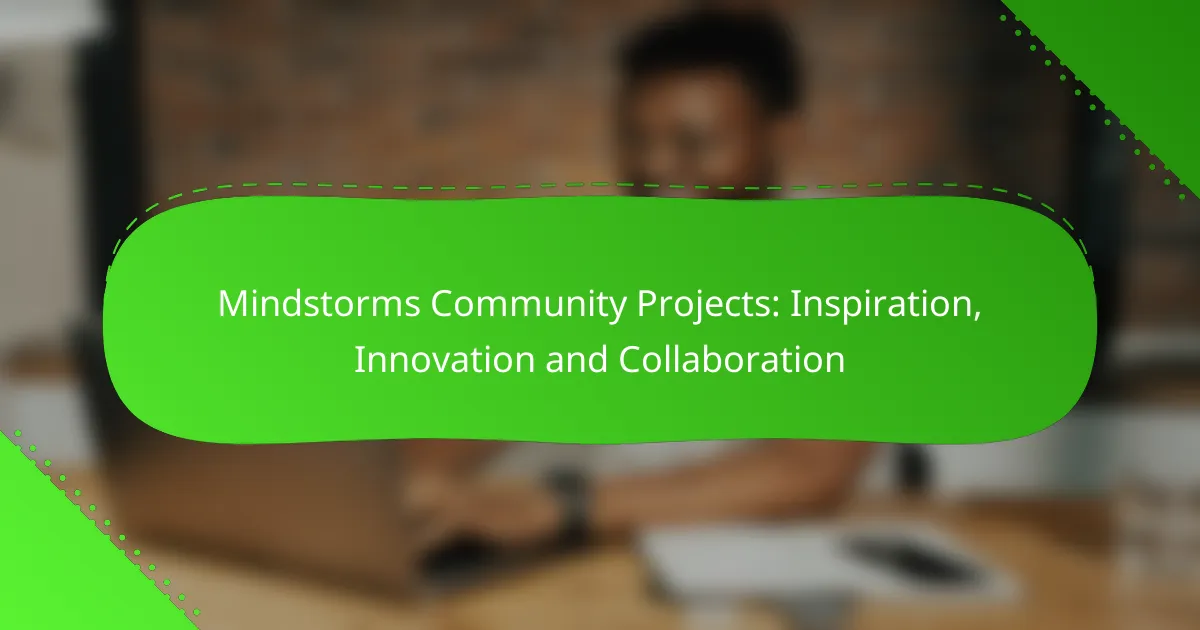Mindstorms Community Projects serve as a catalyst for innovation by highlighting creative robotics applications that address real-world challenges. These initiatives promote collaboration among enthusiasts, providing a platform for idea exchange and driving technological progress. By defining clear objectives and fostering effective communication, teams can work together to develop groundbreaking solutions.
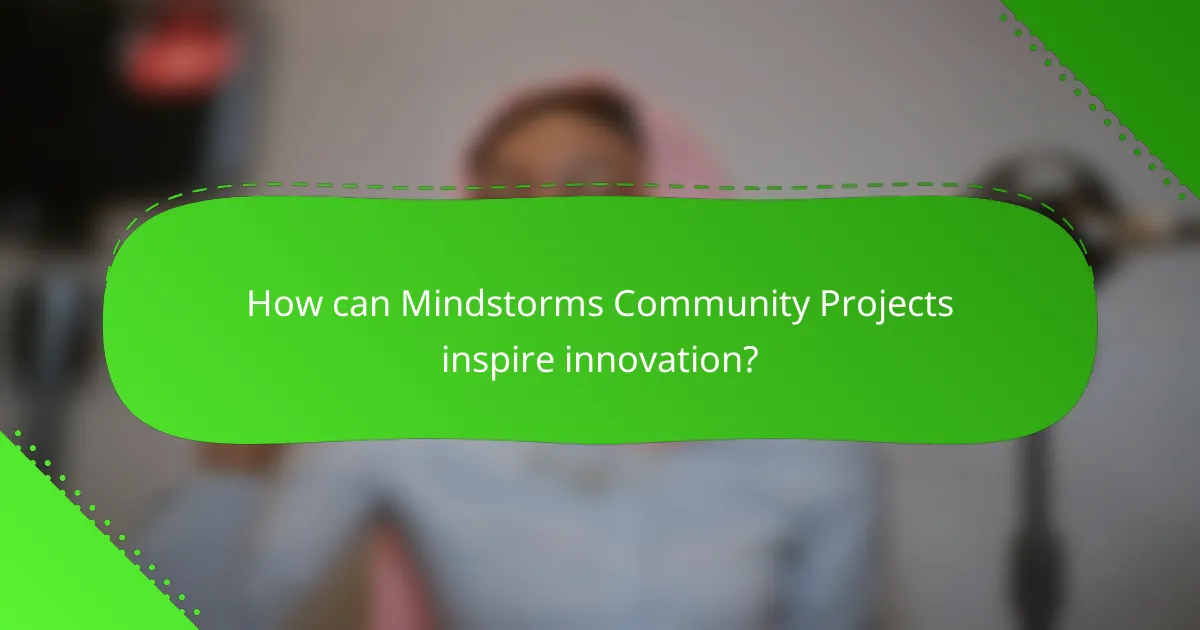
How can Mindstorms Community Projects inspire innovation?
Mindstorms Community Projects can inspire innovation by showcasing creative applications of robotics that solve real-world problems. These projects foster collaboration and provide a platform for sharing ideas, ultimately driving technological advancements.
Real-world project examples
Many Mindstorms projects demonstrate practical solutions to everyday challenges. For instance, a project might involve building a robot that assists with household chores, such as vacuuming or lawn mowing. Another example could be a robot designed to help in educational settings, facilitating interactive learning experiences for students.
These projects often serve as inspiration for others, encouraging users to adapt and improve upon existing designs. By exploring various functionalities, creators can innovate further, leading to enhanced versions of these robots that cater to specific needs.
Community-driven ideas
The Mindstorms community thrives on shared creativity, with users contributing ideas that spark new projects. Online forums and social media platforms allow members to discuss their concepts, share challenges, and offer solutions. This collaborative environment nurtures innovation by pooling diverse perspectives and expertise.
Community-driven ideas often lead to unique projects that might not have been conceived in isolation. For example, a group might collaborate on a robot that combines elements from various individual projects, resulting in a more versatile and capable machine.
Collaborative design processes
Collaborative design processes in the Mindstorms community typically involve brainstorming sessions, prototyping, and iterative testing. Participants often use tools like shared digital workspaces to document their progress and gather feedback from peers. This approach helps refine ideas and improve project outcomes.
Engaging in collaborative design encourages participants to learn from one another, fostering a culture of continuous improvement. By embracing open communication and constructive criticism, teams can develop more innovative solutions that leverage the strengths of each member’s contributions.
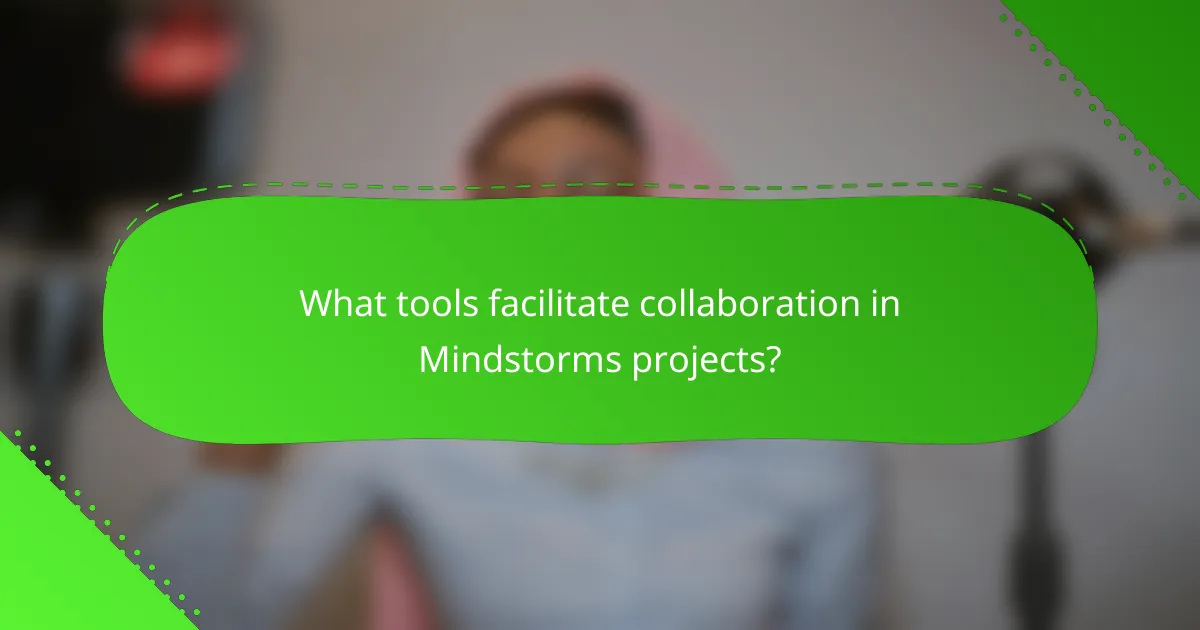
What tools facilitate collaboration in Mindstorms projects?
Collaboration in Mindstorms projects is enhanced by various tools that streamline communication, project management, and software development. These tools help teams share ideas, track progress, and build innovative solutions together.
LEGO Mindstorms software
The LEGO Mindstorms software provides a user-friendly interface for programming robots and managing projects. It includes features like drag-and-drop programming, which allows users to easily create complex behaviors without extensive coding knowledge.
Additionally, the software supports various programming languages, enabling collaboration among users with different skill levels. Teams can work together on projects by sharing code snippets and project files, fostering a collaborative environment.
Online forums and platforms
Online forums and platforms, such as the LEGO Ideas community and dedicated Mindstorms groups, serve as valuable resources for collaboration. These platforms allow users to share their projects, seek advice, and provide feedback to one another.
Engaging in these communities can lead to inspiration and innovation, as members often showcase unique builds and solutions. Users can also participate in discussions about best practices, troubleshooting, and new features, enhancing the collaborative experience.
Project management tools
Project management tools like Trello or Asana can significantly improve collaboration in Mindstorms projects by organizing tasks and timelines. These tools help teams assign responsibilities, set deadlines, and track progress, ensuring everyone is aligned on project goals.
Using project management software can help prevent common pitfalls, such as miscommunication and missed deadlines. Teams should establish clear workflows and regularly update their progress to maintain transparency and accountability throughout the project lifecycle.
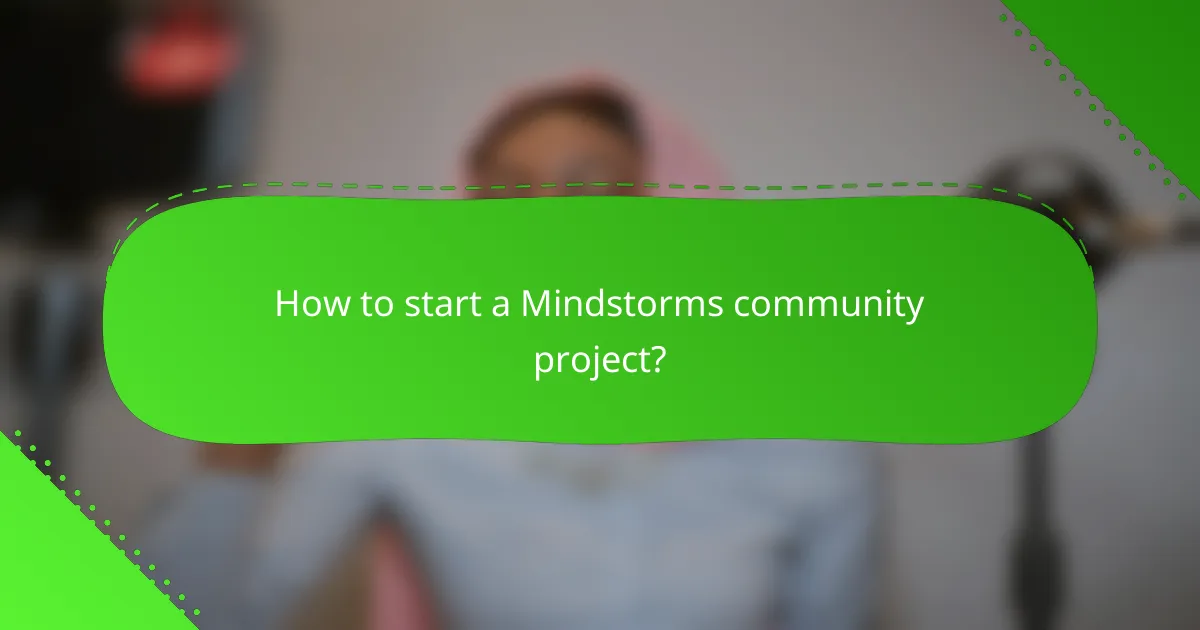
How to start a Mindstorms community project?
Starting a Mindstorms community project involves defining clear objectives, assembling a dedicated team, and establishing effective communication. These steps ensure that the project is well-organized and collaborative, leading to innovative outcomes.
Identifying project goals
Clearly defined project goals are essential for guiding your Mindstorms community project. Consider what you want to achieve, whether it’s building a specific robot, solving a problem, or creating an educational resource.
Use the SMART criteria—Specific, Measurable, Achievable, Relevant, Time-bound—to frame your goals. For example, instead of saying “build a robot,” specify “design a robot that can navigate a maze within three minutes.” This clarity helps in tracking progress and maintaining focus.
Gathering a team
Assembling a team with diverse skills is crucial for the success of your project. Look for individuals who have experience with Mindstorms, programming, engineering, or project management. A well-rounded team can tackle various challenges effectively.
Consider using local community boards, online forums, or social media groups to find interested participants. Aim for a team size that allows for collaboration but is small enough to facilitate decision-making—typically between four to eight members works well.
Setting up communication channels
Effective communication is vital for collaboration in a Mindstorms community project. Establish clear channels for sharing ideas, updates, and feedback. Tools like Slack, Discord, or dedicated project management software can enhance communication.
Set regular check-ins to discuss progress and challenges, and encourage open dialogue among team members. This helps in building a supportive environment where everyone feels valued and engaged in the project.
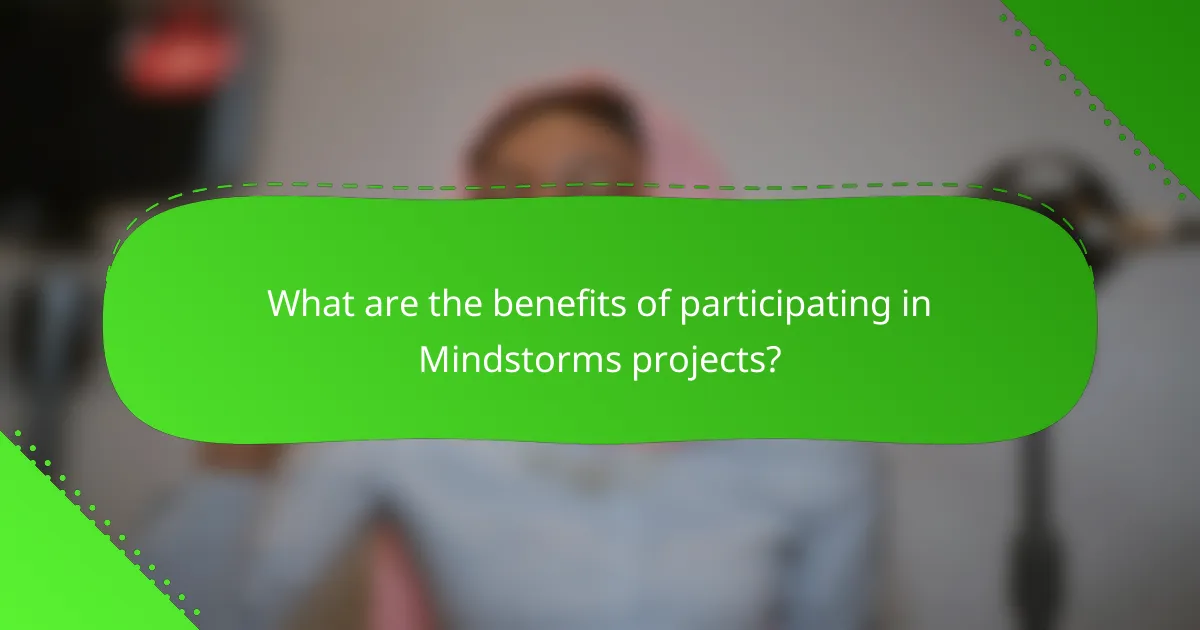
What are the benefits of participating in Mindstorms projects?
Participating in Mindstorms projects offers numerous advantages, including enhanced skills, valuable networking, and access to essential resources. Engaging in these collaborative efforts can significantly boost your technical and creative capabilities while connecting you with like-minded individuals.
Skill development
Mindstorms projects provide an excellent platform for skill development, particularly in areas like programming, robotics, and problem-solving. Participants often learn to work with various programming languages and tools, enhancing their technical proficiency.
Additionally, these projects encourage critical thinking and creativity, as participants must devise innovative solutions to complex challenges. Engaging in hands-on activities helps solidify theoretical knowledge through practical application.
Networking opportunities
Joining Mindstorms projects opens doors to networking opportunities with fellow enthusiasts, educators, and industry professionals. Collaborating with others allows you to share ideas, gain insights, and build relationships that can be beneficial for future endeavors.
Many participants find mentors or collaborators through these projects, which can lead to job opportunities or partnerships in the tech and robotics fields. Attending community events or online forums can further expand your professional network.
Access to resources
Participants in Mindstorms projects often gain access to a variety of resources, including tools, software, and educational materials. Many community platforms provide shared libraries of code, tutorials, and project ideas that can accelerate learning and innovation.
Additionally, some organizations may offer grants or funding for collaborative projects, making it easier to acquire necessary materials. Leveraging these resources can significantly enhance the quality and scope of your work in Mindstorms initiatives.

What are the challenges faced in Mindstorms community projects?
Mindstorms community projects often encounter several challenges that can hinder progress and collaboration. Key issues include resource limitations, coordination problems, and time management difficulties.
Resource limitations
Resource limitations refer to the constraints in materials, funding, and access to technology that can impact project development. Many community projects operate on tight budgets, which can restrict the types of components that can be used, leading to compromises in design and functionality.
To mitigate resource limitations, teams can prioritize essential components and seek donations or sponsorships from local businesses. Collaborating with educational institutions may also provide access to additional resources and expertise.
Coordination issues
Coordination issues arise when team members struggle to communicate effectively or align their efforts towards common goals. This can lead to misunderstandings, duplicated work, or missed deadlines, ultimately affecting project outcomes.
Establishing clear communication channels and regular check-ins can help address coordination challenges. Utilizing project management tools can also facilitate collaboration by keeping everyone informed about progress and responsibilities.
Time management
Time management is crucial in community projects, as teams often juggle multiple commitments. Poor time management can lead to rushed work, increased stress, and incomplete projects.
To improve time management, teams should set realistic deadlines and break projects into manageable tasks. Creating a timeline with milestones can help track progress and ensure that all members are aware of upcoming deadlines.
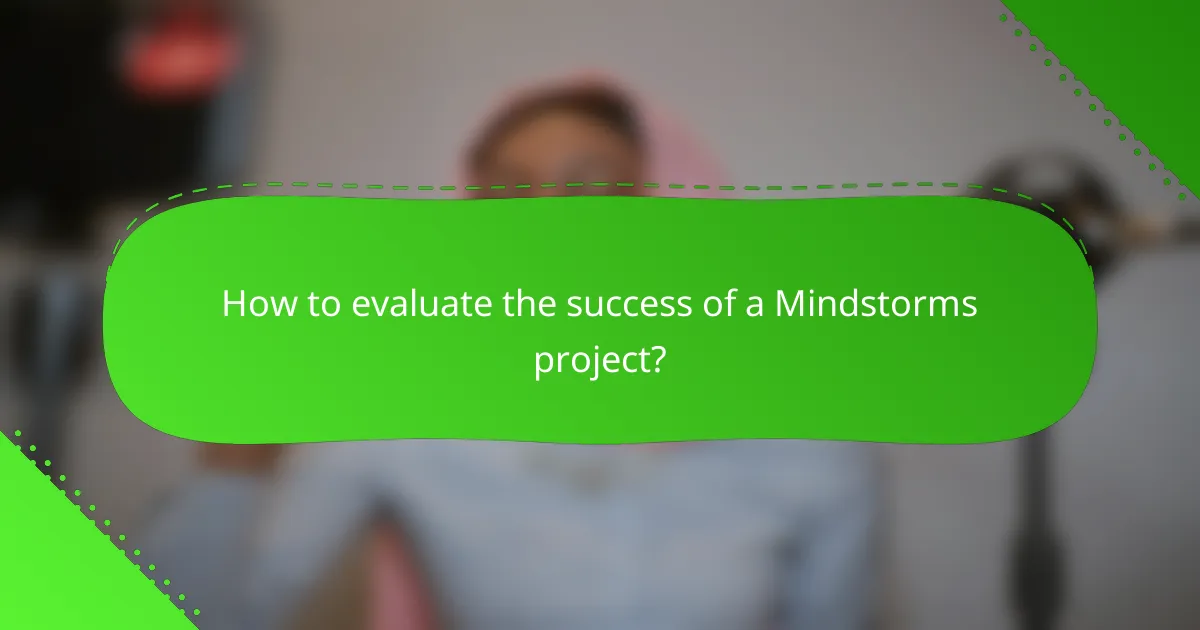
How to evaluate the success of a Mindstorms project?
Evaluating the success of a Mindstorms project involves assessing project outcomes, gathering participant feedback, and conducting long-term impact assessments. These criteria help determine the effectiveness and sustainability of the project while providing insights for future improvements.
Project outcomes
Project outcomes refer to the tangible results achieved through the Mindstorms initiative. This can include the functionality of the robots created, the complexity of the tasks they can perform, and the overall satisfaction of the project goals. Consider using metrics such as completion rates, performance benchmarks, and adherence to project timelines.
To effectively measure outcomes, establish clear objectives at the project’s outset. For example, if the goal is to build a robot that can navigate a maze, assess how well the robot performs this task compared to initial expectations. Documenting these results can provide valuable data for future projects.
Participant feedback
Gathering participant feedback is crucial for understanding the user experience and the educational value of the Mindstorms project. Surveys and interviews can be effective tools for collecting insights on what participants enjoyed, what challenges they faced, and how the project could be improved. Aim for a mix of quantitative ratings and qualitative comments.
Consider implementing a feedback loop where participants can share their thoughts throughout the project, not just at the end. This ongoing dialogue can help identify issues early and foster a sense of community among participants, enhancing their overall experience.
Long-term impact assessment
Long-term impact assessment evaluates how the Mindstorms project influences participants beyond the immediate experience. This may include tracking skills development, such as problem-solving and teamwork, or observing continued engagement with robotics and technology. Assessing these impacts can provide insights into the project’s lasting value.
To conduct a thorough assessment, consider follow-up surveys or interviews several months after project completion. This can reveal whether participants have pursued further education or projects in robotics, indicating the project’s effectiveness in inspiring ongoing interest and innovation.
